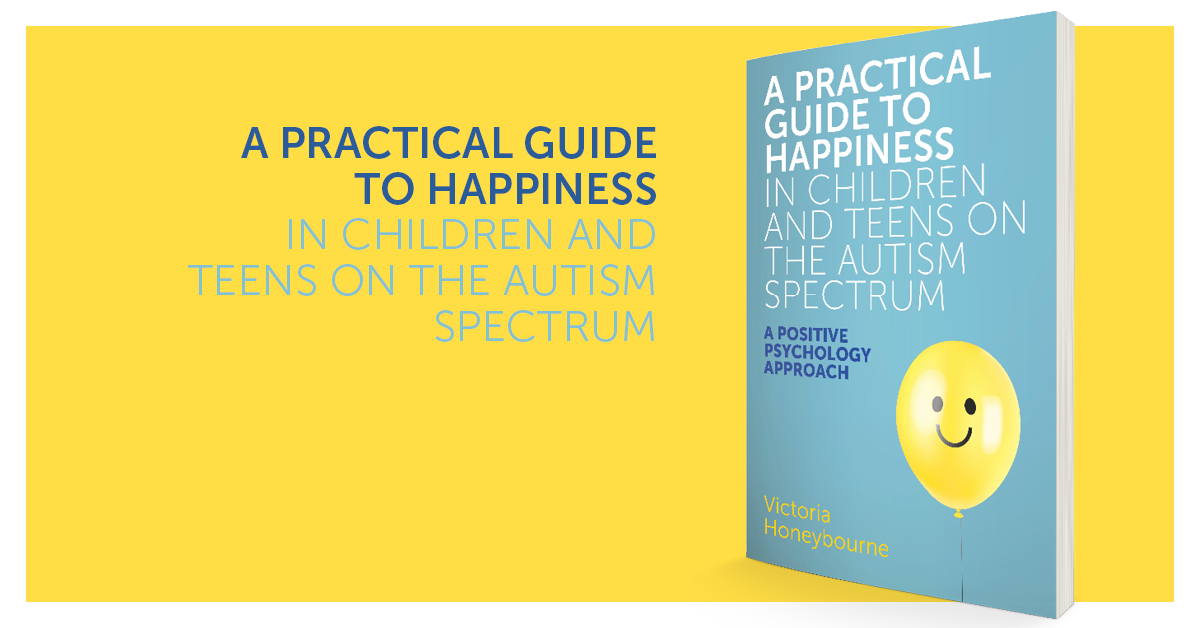Victoria Honeybourne is a senior advisory teacher, trainer and writer with a particular interest in promoting wellbeing amongst young people on the autism spectrum. We caught up with Victoria upon the publication of her latest book, A Practical Guide to Happiness in Children and Teens on the Autism Spectrum, to ask a few questions about how it came about.

What motivated you to write A Practical Guide to Happiness in Children and Teens on the Autism Spectrum and who is the book for?
There has been a lot of interest recently in using findings from the positive psychology movement to improve happiness, wellbeing and resilience in children and young people. However, I realised that many of the strategies advised were not always the most appropriate for those on the autism spectrum. I wanted to write a book which looked at these issues from an autistic point of view. The book is for anybody working with children and young people on the autism spectrum – mainstream teachers, teaching assistants, mentors, speech and language therapists, and parents.
What is meant by the term ‘Positive Psychology’?
Positive psychology has sometimes been called ‘the scientific study of happiness’! Psychology has traditionally concerned itself with deficits, disorders and what is ‘wrong’. In comparison, the positive psychology movement investigates the more positive aspects of human existence such as positive emotions, coping positively and flourishing.
Can you tell us a little bit about your own background and how you came to be interested in the subjects you write about?
My interest in autism came about because of my own diagnosis of Asperger Syndrome which I received as a young adult. I was beginning a career in education at the time so I then went on to specialise in working with students with various special educational needs. I am writing from both personal and professional perspectives.
To what extent do you think happiness can be learned?
An oft-quoted statistic is that happiness is 50% genetic, 10% due to life circumstances and 40% can be learned, but in some ways I disagree with this. Happiness is not an easy concept to define or to measure. Happiness can be short-term (‘I’m happy when I’m eating chocolate / with my friends’) or more long-term (‘I generally feel happy with life’). Longer-term happiness, or flourishing, is not about being ‘happy’ or joyful all of the time, but rather about experiencing the whole range of human emotions and being able to cope appropriately. Societal and cultural expectations and influences can also affect our happiness levels. I therefore think that happiness certainly can be taught and learned – often it is a case of changing perspective, on individual, group and societal levels.
In what ways might children and teens on the autism spectrum have unique concerns about happiness and mental health?
Happiness and wellbeing can be areas of great concern to many children and young people, for many different reasons. However, those on the autism spectrum can have additional difficulties in these areas. Sometimes the difficulties come about simply from living in a neurotypical world which tries to impose neurotypical views. So, for example, a ‘neurotypical’ person might assume that being on your own means you are unhappy, but for some autistic individuals, this might be when they are actually at their happiest! If you are constantly surrounded by people and a society which tries to impose just one way of being, then this can have a negative impact on self-esteem and self-worth.
What can readers expect to find inside A Practical Guide to Happiness in Children and Teens on the Autism Spectrum?
The book covers topics such as character strengths, happiness, optimism, gratitude, flow, resilience, wellbeing and a growth mindset. Each chapter explores some of the differences for young people on the autism spectrum compared to neurotypical individuals. For each topic various group activities, individual activities and adult communication strategies are suggested.
What advice from the book do you use in your own life?
Lots of it! On a personal level, I’ve found it incredibly useful over the years to become more aware of my strengths, my values and my sensory needs. Keeping a journal is also something I find works well for me. Professionally, I’ve found that just changing the language and way I communicate with young people can make a huge difference to their level of anxiety and sense of wellbeing.
If you would like to read more articles like this and get the latest news and offers on our books about autism, why not join our mailing list? We can send information by email or post as you prefer. You may also be interested in liking our Autism, Asperger’s and related conditions Facebook page.